 |
|
Here and There introduces art, artists, galleries and museums around Japan that non-Japanese readers and first-time visitors may find of particular interest. The writer claims no art expertise, just a subjective viewpoint acquired over many years' residence in Japan.
|
|
 |
|
|
 |
 |
Samurai Surrealism: Tetsuya Noguchi at the Nerima Art Museum
Alan Gleason |
 |
 |
|
| Rocket Man (2007) |
Every few years an artist gains cachet with pictures of hamburger-munching geishas and the like, painted in the fashion of ukiyoe or Nihonga. Though the gimmick is fun the first time, after a while it gets pretty predictable -- good for a laugh or two, but hardly the trenchant commentary on "traditional vs. modern" that the artist usually proclaims it to be.
The best practitioners of this genre (Masami Teraoka comes to mind) make it work not because of the obvious satire, but because of their mastery of the classical art form used to set up the spoof. And once in a while the artist's technique is so exquisite that it elevates the work entirely out of the realm of parody, however droll the subject matter.
Tetsuya Noguchi's work is just such an example. His forte is painting or sculpting samurai, clad in the armor of the feudal era, but always with an off-the-wall element. One warrior is riding a bicycle; another wears headphones; still another carries an attaché case. An entire regiment floats through the air, suspended by beanie-propellers whirring over their heads. There is a miniature samurai in a bottle, a warrior wearing an animate helmet that talks to him, and a series of armor-clad cats, including one on a leash, scampering along ahead of his master -- who wears a helmet topped with two resplendent cat ears.
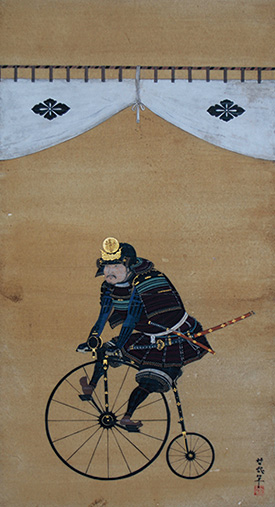 |
|
 |
|
|
|
| Armored Warrior Going into Battle on a Bicycle (2013) |
|
Small Soldier (2008) |
Noguchi's solo exhibition at the Nerima Art Museum on the northwest side of Tokyo fills three sizable galleries with work in this vein. Though there are plenty of laugh-out-loud moments, the joke would wear thin but for the exquisite craftsmanship Noguchi displays throughout. His paintings, which could easily be mistaken for faithful reproductions of Edo-era works, are all subdued hues and earthy textures on paper or wood, with traditional patterned-cloth borders -- yet the paint is acrylic. Interspersed as points of reference among Noguchi's originals are some genuine centuries-old portraits of samurai, and were it not for the wacky motifs of the former they would be virtually indistinguishable.
Noguchi is also a master caricaturist whose sculpted human figures (all made with resin and synthetic fiber) are comically lifelike. The hilarity stems not from any attempt to make silly faces for cheap laughs -- the samurai are uniformly deadpan -- but from the placement of those very human, somewhat dour visages in absurd contexts.
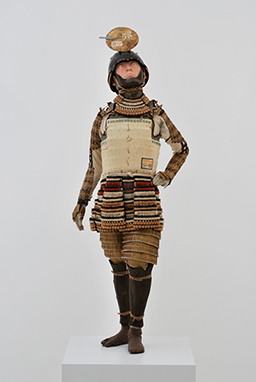 |
|
 |
|
|
|
| Positive Contact (2011) |
|
Partial view of Talking Head (2010) |
The artist is happy to extemporize at length about his intentions, both in the captions on the walls and in the accompanying catalog. He describes his work as an intersection of several interests -- obsessions, really -- that have captivated him since his youth: history, science-fiction films, plastic models, and samurai armor. His first epiphany came, he says, when he saw a photograph taken at the end of the shogunate era of an armored samurai, looking less like one of the noble warriors exalted in period paintings and more like the "mutant offspring of a human and a lobster." Another source of inspiration was Tomoto Kobori (1864-1931), a Nihonga painter and scholar of ancient court and military practices who made, and dressed up in, his own meticulously replicated samurai armor.
Noguchi's talent for parody and homage extends to the written word. One of the pleasures of this exhibition is reading his commentaries on the works on display. Written in a perfect sendup of the stodgy, ploddingly detailed prose of academic curators, they offer poker-faced "background" on the crazy goings-on in the pictures. The caption for Armored Warrior Going into Battle on a Bicycle, for example, calls attention to the exquisite ornamentation on the bicycle struts, with its pattern of "flower-rhombus family crests . . . suggesting that the rider is a personage of high social status, although there no clues available as to his identity" (my tentative translation).
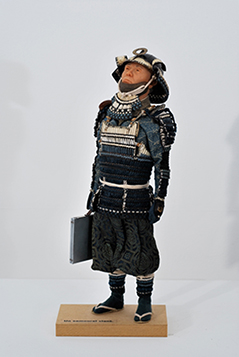 |
|
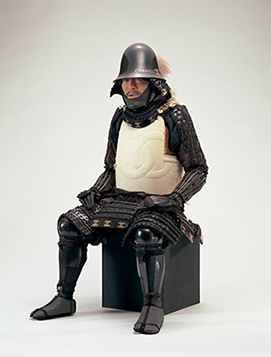 |
|
|
|
| Un samourai vient (2012) |
|
Chanel Samurai (2009);
© Tetsuya Noguchi / Collection: Chanel K.K. |
In a running joke that Noguchi milks in a series of paintings and sculptures, the interlocked C's of the Chanel logo appear as a samurai crest (and a very authentic-looking one indeed). One of the attendant captions describes how in the fifth year of the (fictitious) Enpo era, a samurai received from his master, in recognition of exploits in battle, a Chanel-brand handbag and permission to adopt the logo as a crest (as well as change his family name to Shaneru, written in kanji). The explication goes on to point out that goods from Europe enjoyed special status among Japan's elite during this period . . . What makes the entire conceit almost plausible is the fact that the age of the samurai did overlap with the modern era, producing sometimes jarring imagery like the photo-portrait Noguchi saw in his youth. It is probably a good thing that his commentaries all end with a fine-print demurral that "the above is entirely a figment of the artist's imagination."
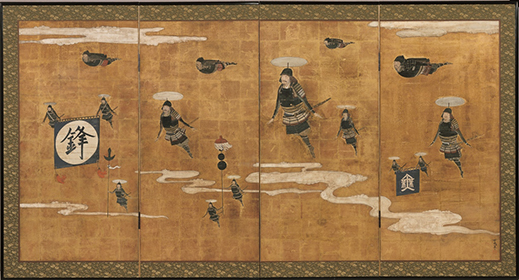 |
|
Screen Painting of Floating Warriors (2008)
All works shown are by Tetsuya Noguchi;
images are courtesy of the Nerima Art Museum. |
Given the cost and time required to prepare parallel English texts for an entire exhibition, it is understandable that the Nerima Art Museum chose not to do so for the Noguchi show -- but more's the pity, since these faux-commentaries are such an integral part of the presentation. Fortunately the images speak for themselves and will elicit guffaws and admiration from any visitor, Japanese-reader or not. Unfortunately they will only be up until April 6, but if you are in the area before then, this exhibition is well worth the trip to Nakamurabashi, just a few minutes by train west of the Yamanote Line loop around central Tokyo.
|
|

 |
Tetsuya Noguchi Exhibition: Historical Odyssey |
 |
Nerima Art Museum |
 |
16 February - 6 April 2014 |
| |
1-36-16 Nukui, Nerima-ku, Tokyo
Phone: 03-3577-1821
Hours: 10 a.m. - 6 p.m. (last admission at 5:30 p.m.)
Closed Monday (or Tuesday when Monday is a national holiday), preparation periods between exhibitions, and 29 December - 3 January
Access: 3-minute walk from Nakamurabashi Station on the Seibu Ikebukuro Line |
|
|
|
|
 |
Alan Gleason
Alan Gleason is a translator, editor and writer based in Tokyo, where he has lived for 28 years. In addition to writing about the Japanese art scene he has edited and translated works on Japanese theater (from kabuki to the avant-garde) and music (both traditional and contemporary). |
|
|
|
|
|
|
|
|
|
 |
|